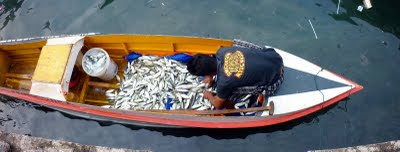BUKIT TENGKORAK (SKULL HILL) ARCHAEOLOGICAL HERITAGE SITE

"It is estimated that more than 6 million prehistoric potsherds can be found all over this hill" as written on a signboard at the archaeological site.
This broken piece I am holding (above photo) is from a 3000 years old pot made on the hill.
It’s Labor Day, our whole family has an outing to Semporna. A town 105 Km 1.5 hours drive from our home. Our main destination is this BUKIT TENGKORAK ARCHAEOLOGICAL HERITAGE SITE, a major pottery producing site 3,000 years ago.
It’s a dizzying day that ruined much of the fun of an outing that other wise a joyous holiday outing.
Visitor Center of the site was complete only in 2010 and is a new tourist attraction in Sabah.
This is a RM4.2 million project by Malaysia National Heritage Department aimed at preserving the historical site which showed the area's civilization
Bukit Tengkorak is one of Sabah sites with the highest prehistoric value. An important archaeological site in South-East Asia.
Situated 500 feet above sea level, Skull Hill was a volcanic rock cave and formed part of the rim of a 2km-wide volcanic crater, surrounded by numerous isolated hills and mountains.
Universiti Sains Malaysia and Sabah Museum Department since 1994 found 3 important items aged over 3,000 years on this SKULL :
1) pieces of porcelain,
2) stone equipment
3) food remnants from various marine species
Walking up the wooden stairs on the upper forested area will lead you to the site.
At the foot hill is a museum for visitors to view its historical finds.
Archeological research uncovered pottery shards in layers of ash which were probably remnants of open kilns used for firing pottery.
Historical studies point to trading between the people of Bukit Tengkorak and other prehistoric communities along the southeastern coast of Sabah.
Archaeologists believed that long-distance sea trade and migration of people in insular SEA and the Pacific moved east from Melanesia (near Papua New Guinea) to Polynesia, leaving behind what is known as the “Lapita culture” of pottery, stone tools and ornaments.
“Our research at Bukit Tengkorak shows that 3,000 years ago, people were not only moving east towards New Britain in Melanesia but also westwards towards Sabah.............This is one of the longest trading routes in the world during the Neolithic period.....”
Archeochemist Dr Stephen Chia
of University Science Malaysia
who based his PhD thesis on the site.
Dr Stephen Chia found obsidian (a volcanic glass used to make tools) at the site and traced it chemically to Talasea in New Britain, 3,500 kilometers away. His fieldwork in Southeast Asia also found stone tools and pottery similar to Bukit Tengkorak in the Zamboanga Peninsula, the Sulu Archipelago and Sulawesi.

















































